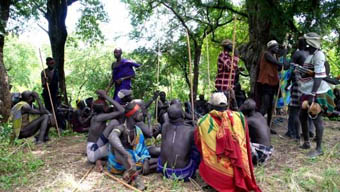
The Botanical Garden hosts the exhibition ‘A l’Ombra del Ragai, la relació del poble mursi amb les plantes del seu entorn’, a photographic tour through the life and landscape of this community which is in the collective imagination of women with labial dishes and men with fighting sticks.
However, this is a claim, especially for tourists, which is not free from polemics, though in fact it is just a detail among the complexity of their culture and customs, all them strongly tied to the land and the environment.
With about thirty photos that make up the exhibition, as well as the objects brought from different trips, it is supposed to deepen the Mursi town, an agricultural and livestock group in south-western Ethiopia. Who are they, how they live, what are their customs and rituals, and from where his close links with elements like trees comes. In fact, the Ragai is what we know as tamarind, ‘Tamarindus indica’, of the legume family.
So, it is emphasized the symbolic aspect of these relationships, the key elements of their identity, marking how important it can be to conserve plant diversity for, at the same time, preserving cultural diversity. And plants, bushes and trees are not only a part of the landscape where the Mursi live, they are also permanent source of resources and a key to understand their view of themselves and the world.
Yet, it does not only aim to reflect the deep knowledge of the plant world of this village, but also to pay attention to current transformations that it is suffering. On the one hand, due to the progresses around it that, although gathering them sparingly, are always modifying their ideas of things and affecting them. And on the other hand, the Ethiopian government and several foreign companies that have developed their activities in the area, over Mursi lands. All they have enabled and promoted that, through time, practically all the river banks have become sugar cane plantations. It could be a problem and a new challenge for the mursi.
The exhibition has over thirty photos and twenty objects made from plant materials, supported with maps and texts, an audio-visual documentary of the NGO Survival, and even it will be able to hear some of their songs. Sections of the exhibition, dedicated to the people, the land, the plant world, the tree as a symbol and challenges and future, the visitor will discover oral tradition, everyday life, lives tied to rivers, diversity of African trees and bushes, the uses of plant material of all types, ceremonies, rituals, songs and much more.
‘A l’Ombra del Ragai’ is a project of Anna Albiach and Joan Salazar, authors of the photographs and texts too, designed specifically for the Botanical Garden. Also organised by Mursiland Heritage Project, it has the collaboration of Survival International and Human Rights Watch, as well as other participants who provided some special photos or his scientific advice.
In the past six years Joan Salazar, archaeologist, and Anna Albiach, biologist, have been part, through the Mursiland Heritage Project, of a research project focused on the Mursi territory centred in the material culture, the archaeology and the vision of these people on their own territory. This has led them to visit Ethiopia up to six times, to live with them for seasons, and to get now photographs and objects that take the viewer for a while to their experiences.
The exhibition can be seen at the Exhibition Hall of the Botanical Garden until 1 June. Entrance is free, and the schedule is from Monday to Sunday from 10:00 to 20:00.
Last update: 4 de april de 2014 07:38.
News release



















